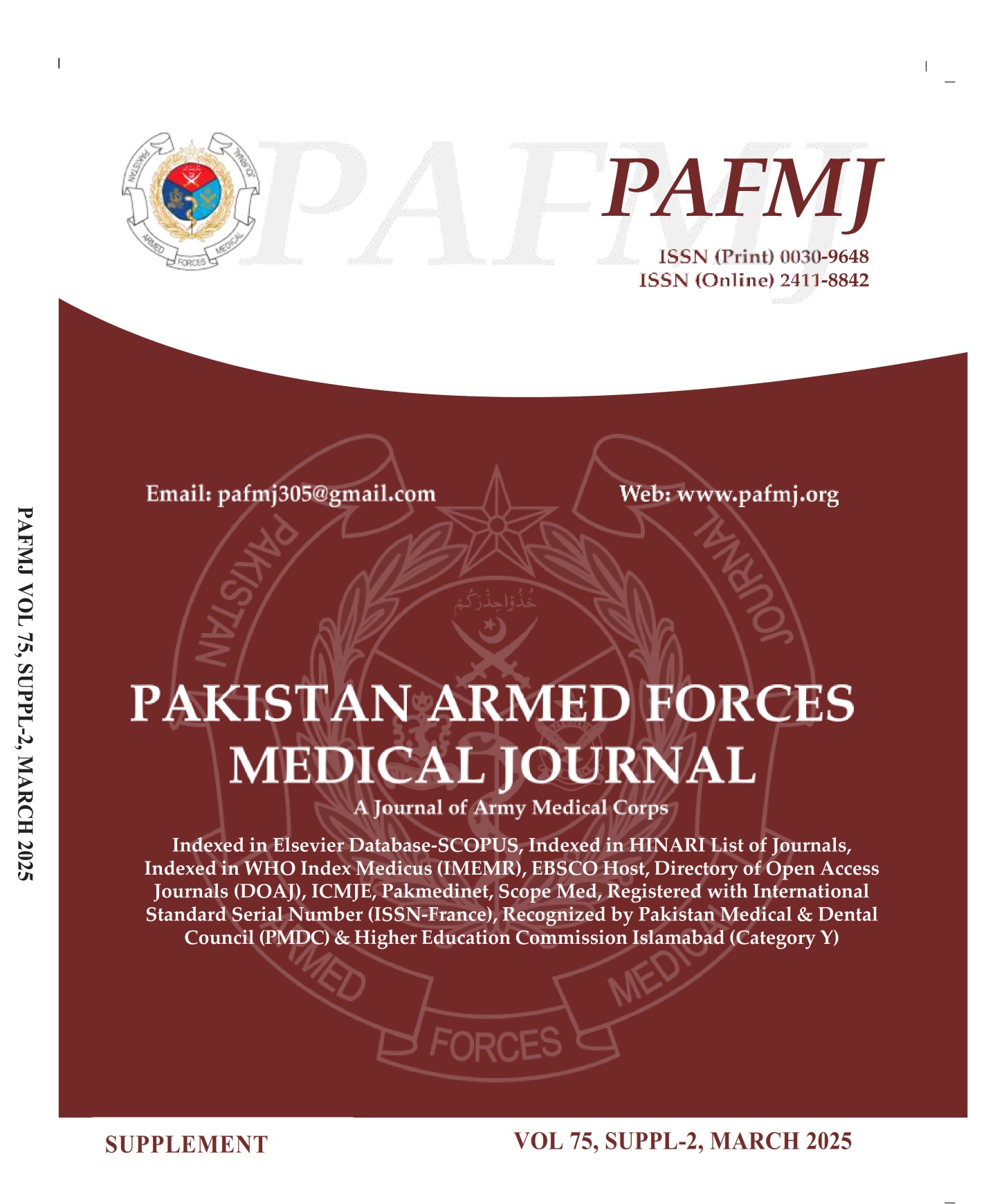Current Pattern of Respiratory Pathogens and Their Sensitivity in Low Socio-Economical Female Population of Tertiary Care Hospital
DOI:
https://doi.org/10.51253/pafmj.v75iSUPPL-2.9868Keywords:
Antimicrobial susceptibility test, Multidrug resistance (MDR), Respiratort tract infectionsAbstract
Objective: To determine the current pattern and antimicrobial sensitivity of respiratory pathogens in low socio-economical female population reporting to tertiary care hospital.
Study Design: Cross-sectional study.
Place and Duration of Study: Microbiology department, Fauji Foundation Hospital, Rawalpindi Pakistan, from October 2021 to September 2022.
Methodology: The study was conducted on out-door and in-door female population presented with symptoms and signs of respiratory tract infections like fever, cough and dyspnea. The specimen included were nasal swab, throat swab, sputum, pleural fluid, tracheal tube culture and bronchial washings for culture and sensitivities.
Results: Among 290 above mentioned specimens that yielded the growth of bacteria, Pseudomonas aeruginosa was most frequently isolated i.e in 124(42.7%) followed by Acinetobacter baumannii in 63(21.7%), Klebseilla species in 28(9.6%), Eschrechia coli in 20(6.9%), Methicillin resistant Staphylococcus aureus (MRSA) in 18(6.2%), Staphylococcus aureus in 09(3.1%), and several other gram positive and gram negative organisms.
Being a part of developing country, it is one of the leading cause of frequent hospital visits and medications. Female population of low socio-economic ethnic group was most prevalent. Gram negative organisms were seen in highest percentages and were showing resistance to commonly used antibiotics like ampicillin, co-amoxiclav, cephalosporins, aminoglycosides, and quinolones.
Conclusion: To overcome the problem of multidrug resistance and for better treatment outcome, the results for culture and sensitivities should be consulted and relied upon. It gives us better insight towards the prevalent organisms in our set up and the effective treatment options for respiratory tract infections.
Downloads
References
Gebre AB, Begashaw TA, Ormago MD. Bacterial profile and drug susceptibility among adult patients with community acquired lower respiratory tract infection at tertiary hospital, Southern Ethiopia. BMC infectious diseases 2021; 21(1): 1-10.
Bilal H, Khan MN, Rehman T, Hameed MF, Yang X. Antibiotic resistance in Pakistan: a systematic review of past decade. BMC Infectious Diseases 2021; 21(1): 1-19.
Helou M, Mahdi A, Daoud Z, Mokhbat J, Farra A, Nassar E, et al. Epidemiology of Community-Acquired Respiratory Tract Infections in Patients Admitted at the Emergency Departments. Tropical Medicine and Infectious Disease 2022; 7(9): 233.
Salahuddin N, Khalid M, Baig-Ansari N, Iftikhar S. Five-year Audit of Infectious Diseases at a Tertiary Care Hospital in Karachi, Pakistan. Cureus 2018; 10(11).
Saleem Z, Hassali MA, Godman B, Fatima M, Ahmad Z, Sajid A, et al. Sale of WHO AWaRe groups antibiotics without a prescription in Pakistan: a simulated client study. Journal of pharmaceutical policy and practice 2020; 13(1): 1-8.
Torumkuney D, Anwar S, Nizamuddin S, Malik N, Morrissey I. Results from the Survey of Antibiotic Resistance (SOAR) 2015–17 in Pakistan: Data based on CLSI, EUCAST (dose-specific) and pharmacokinetic/pharmacodynamic (PK/PD) breakpoints. Journal of Antimicrobial Chemotherapy 2020; 75(S_1): i76-i87.
Malik F, Figueras A. Continuous rise in cephalosporin and fluoroquinolone consumption in Pakistan: a 5 year analysis (2014–18). JAC-antimicrobial resistance 2019; 1(3): dlz063.
Cantón R, Akova M, Langfeld K et al. Relevance of the Consensus Principles for Appropriate Antibiotic Prescribing in 2022. J Antimicrobial Chemother 2022; 77(S1): dkac211.
Hayat C, Jamshed S, Rosenthal M et al. Understanding of pharmacy students towards antibiotic use, antibiotic resistance and antibiotic stewardship programs: a cross-sectional study from Punjab, Pakistan. Antibiotics 2021; 10: 66.
Inoue H. Strategic approach for combating antimicrobial resistance (AMR). Global Health Med 2019; 1: 61–64.
Klein EY, Van Boeckeld TP, Martinez EM et al. Global increase and geographic convergence in antibiotic consumption between 2000 and 2015. Proc Natl Acad Sci USA 2018; 115: E3463–E3470.
Jain S, Self WH, Wunderink RG et al. Community-acquired pneumonia requiring hospitalization among U. S. adults. N Engl J Med 2015; 373: 415–427.
Thomas AM, Jayaprakash C, Amma GM. The pattern of bacterial pathogens and their antibiotic susceptibility profile from lower respiratory tract specimens in a rural tertiary care centre. J Evolution Med Dent Sci 2016; 5(40): 2470-2476.
Giske CG, Turnidge J, Cantón R, Kahlmeter G. Update from the European committee on antimicrobial susceptibility testing (EUCAST). Journal of Clinical Microbiology 2022; 60(3): e00276-21.
Metlay JP, Waterer GW, Long AC et al. Diagnosis and treatment of adults with community-acquired pneumonia. An official clinical practice guideline of the American Thoracic Society and Infectious Diseases Society of America. Am J Respir Crit Care Med 2019; 200: e45–e67.
Kliemann BS, Levin AS, Moura ML et al. Socioeconomic determinants of antibiotic consumption in the state of São Paulo, Brazil: the effect of restricting over-the-counter sales. PLoS One 2016; 11: e0167885.
Organization WH. Policy paper on traceability of medical products. 2021.
CLSI guidelines for antimicrobial sensitivity testing 2022.
https://clsi.org/standards/products/microbiology/documents/m100/
EUCAST. Implementation of EUCAST breakpoints/guidelines. 2022. https://www.eucast.org/fileadmin/src/media/PDFs/EUCAST_files/Statistics /EUCAST_Maps_March_2022.pdf
Waseem H, Ali J, Sarwar F et al. Assessment of knowledge and attitude trends towards antimicrobial resistance (AMR) among the community members, pharmacists/pharmacy owners and physicians in district Sialkot, Pakistan. Antimicrob Resist Infect Control 2019; 8: 67.
Helou M, Mahdi A, Daoud Z, Mokhbat J, Farra A, Nassar E, Nehme R, Abboud E, Masri K, Husnis in Patients Admitted at the Emergency Departments. Tropical Medicine and Infectious Disease 2022; 7(9): 233. R. Epidemiology of Community-Acquired Respiratory Tract Infection
Downloads
Published
Issue
Section
License
Copyright (c) 2025 Saima Ishtiaq, Fatima Kareem, Zeeshan Ahmed Alvi, Saima Syed, Haider Ali, Umme Farwa

This work is licensed under a Creative Commons Attribution-NonCommercial 4.0 International License.















